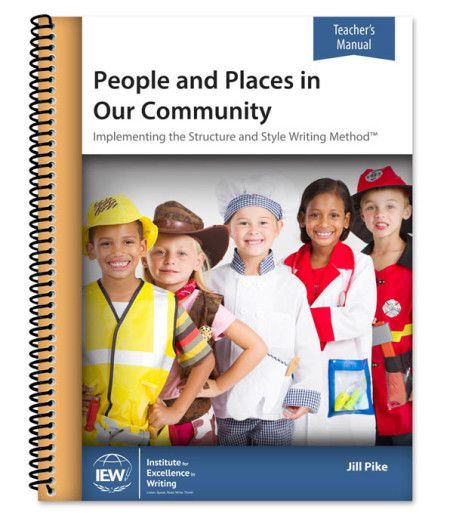We use cookies to make your experience better. To comply with the new e-Privacy directive, we need to ask for your consent to set the cookies. Learn more.
People and Places in Our Community Teacher Book
While writing compositions with stylistic techniques and six of IEW's nine structural units, students will get to know the workers who keep a community running smoothly—from firefighters and police officers to road crews and rescue workers. This Teacher's Manual includes sample key word outlines, comprehension questions, and thorough instructions for activities.
These lessons are designed to be used by an instructor who has been through the Teaching Writing: Structure and Style seminar, either live or on DVD.
Note: The Student Resource Packet is a necessary component of this course.
This supplemental resource is included with your purchase as an e-book for you to download and print. (If you did not place your order online through our website, please check the copyright page for download information.)
Based on specific topics or on events in history, these sets of writing lessons (same grade-range levels as the SSS) offer comprehensive, almost scripted instruction. All necessary source texts have been developed for busy parents and teachers like you. An IEW veteran and aficionado myself, I couldn't conceive of anything more complete than what is provided here. Each lesson offers comprehensive (just short of totally scripted) instruction. All necessary source texts are provided and are reproducible for one parent/one homeschool. Clear assignments (sometimes differentiated between levels) along with a checklist to aid both the student in preparation and the parent in grading. These are also designed to be used by the student to work on throughout the week. Based on specific topics or events in various segments of history, the lessons include grammar exercises, vocabulary development, quizzes, and games for review and reinforcement - along with the writing instruction, of course.
In all lessons students are encouraged to polish their final draft perhaps even adding illustrations. At the end of each course the student will have a personal portfolio collection of poems, stories, reports, essays and research papers. Lessons are taught at the beginning of each week allowing the rest of the week for students to complete the assignment which they should be able to do on their own. Teacher preparation is minimal. (Do I hear an emphatic "Yes!"?)
The courses are targeting a progressively more competent student with the assumption that students are working through the courses according to suggested grade levels. Therefore, there is an increasing complexity to the instructions, expectations, and assignments. Accordingly, teachers are encouraged to be flexible with plans. The beginning writer may need to spend more than the suggested week on difficult lessons or omit some of the grammar. Mature students may move more quickly to allow time for additional research writing and/or more creative essay writing.
Many of these courses can be used equally well within a homeschool with several different aged students and all can be used in a co-op/support school setting with more grade-specific groupings of students. It's assumed that parents/teachers have completed Teaching Writing Structure & Style (TWSS), IEW's DVD seminar for parents and teachers.
Some courses have both a Teacher and a Student Book. In these courses, instruction for the teacher is more extensive and both books are necessary as the course is designed to be interactive between the teacher and student. Teachers should plan to read over the lessons with the students and help as necessary, especially with outlining and brainstorming. A roll of tickets (available at office supply stores) is optional but very useful for encouragement and motivation. ~ Janice
It's perfect! If you've ever wondered what an early elementary version of IEWs Structure and Style writing lessons might look like, wonder no longer. It's here! And, it's everything I might have wished for. The Community, People and Places theme provides a wealth of interesting stories for beginning writers. Structure and Style Units 1-5 and 7 are covered in an age/grade appropriate manner incorporating games and vocabulary cards. Students produce paragraphs, stories, reports, and creative writing. There are 28 lessons and you could cover these in one year in either first or second grade or spread the lessons out over both years.
This book is sensibly organized with a reproducible (for students in a single family) Student Book and an accompanying Teacher's Manual that can either be downloaded (free) from the publisher's website or purchased. The Student Book provides instructional information, source texts, space for completing all assignments, and checklists for each lesson. Vocabulary instruction starts with week 4. Appendices include wordlists, game pieces, and vocabulary cards (printed on colored cardstock). The Teacher Manual has reduced copies of student pages with teaching helps "around the edges". Introductory course information and a Scope and Sequence are found in both books. You will need some additional supplies: 3-ring binder, file folders envelopes or ziplock bags (for storing game pieces), and craft supplies. Additional free downloads include the required Student Resource Packet and writing checklists.
Lessons are a very gentle introduction to IEW's units and could be adapted for older students if desired. Since reading and handwriting skills are still being developed, teachers should plan to do all the writing for the beginning outlines and paragraphs. Students can then copy them. Teachers should also plan to help students as much as is needed. The focus is on modeling. Concepts don't have to be mastered this first time around; they'll be covered again in later IEW writing courses. Student book - 251 pg, spiral-bound. Teacher Manual - 239 pg, spiral-bound. ~ Janice
| Product Format: | Paperback |
|---|---|
| Brand: | Institute for Excellence in Writing |
| Author: | Jill Pike |
| Grades: | K-2 |
| ISBN: | 9781623412814 |
| Length in Inches: | 11 |
| Width in Inches: | 9 |
| Height in Inches: | 0.875 |
| Weight in Pounds: | 1.2875 |

